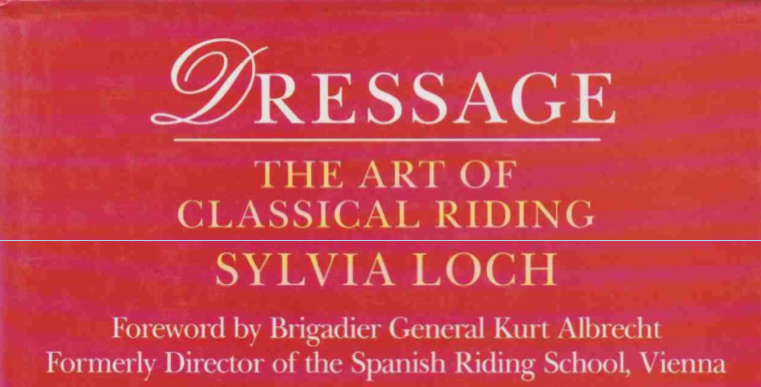
[First published in the U.S.A. in 1990 by Trafalgar Square Publishing, North Pomfret, Vermont, Printed in Great Britain, reissued 2001. © Sylvia Loch 1990. Out of print. 11″ x 8 7/8″ x 1″, 229 high quality glossy pages.]
I am a classicist; I have a deep reverence for important messages that the past has left us. And why do I review out-of-print resources? They can be hard to find, sometimes almost impossible. But I believe they are worth looking for and waiting for (and paying for!) because many 20th books are irreplaceable in the canon of classical equestrian literature…their authors are closer to the “source” than modern ones. What is the “source”? To me, the “source” in classical equitation is represented by a point or place in time where ideals were strong and represented by truly masterful practitioners of the art.
“Dressage: The Art of Classical Riding” is truly glorious reading and packed with history and artwork on every page–much of it in full color–and a book I always keep in my library as a critical reference. I sat down two weeks ago and read it again, cover to cover, when I wanted to make one of my frequent escapes into the past to look for wisdom and inspiration. The author provided both in great detail.
One impression that can be both confusing and fascinating is that a country’s or nationality’s “school” of riding has something unique that the others don’t have. At the same time, the fact is that the various “schools” and their masters had a cross-pollinating effect over the centuries. Loch tells us that this was true to the extent that any rider could go to any country and the aids and the horse’s response to them would be the same in them all.

The mixed lineages come to make sense as Loch explains the riding of antiquity, the historical significance of collected riding, and describes the early Romanic schools of academic equitation in Italy, Portugal and Spain and how they influenced the schools of Austrian, Germany and France. She gives particular attention to the master ecuyers across Europe who authored books and whose students carried on their masters’ work through their own students and books, right into modern times (at the time the book was published). Her mighty five-page bibliography is a great one to study to begin or augment your classical library.
When you have finished reading “Dressage: The Art of Classical Riding,” you will have a much clearer understanding of the place you, your instructors and your horses have come to occupy in the great cavalcade of equestrians and horses through time.
